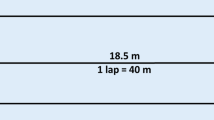Abstract
Background and aims
Fast- and usual-paced 400-m walking tests are often used to assess physical fitness or function, respectively, though it is not known how performance converges on these tests. This study aims to determine whether performance on the fast- and usual-paced 400-m walks varies based upon age and physical function.
Methods
Participants (26 men, 38 women aged 70–92) completed a fast- and usual-paced 400-m walk. The Short Physical Performance Battery was used to assess function (score range 0–12). Body mass index and health history were also assessed.
Results
Finish times for the fast- and usual-paced 400-m walks were 333.3 and 380.3 s, respectively (P < 0.0001), and highly correlated (r = 0.88, P < 0.001). Higher functioning participants (SPPB > 10) had greater differences between tests compared to lower functioning participants (SPPB ≤ 10) (52.9 vs. 26.2 s, P = 0.005), as did younger participants (age < 80) compared to those age 80 and older (56.8 vs. 32.8 s, P = 0.003).
Discussion
Older and lower functioning participants had greater convergence on the fast- and usual-paced 400-m walks. Potentially some of these lower functioning and older adults may have already performed at their maximal capacity during the usual-paced walk, while the younger and higher functioning participants were able to walk substantially faster when asked.
Conclusions
Choice of walking test should consider the age and functional capacity of the population as well as whether function or fitness is of interest.


Similar content being viewed by others
References
Simonsick EM, Fan E, Fleg JL (2006) Estimating cardiorespiratory fitness in well-functioning older adults: treadmill validation of the long distance corridor walk. J Am Geriatr Soc 54(1):127–132. doi:10.1111/j.1532-5415.2005.00530.x
Fielding RA, Rejeski WJ, Blair S, Church T, Espeland MA, Gill TM, Guralnik JM, Hsu FC, Katula J, King AC, Kritchevsky SB, McDermott MM, Miller ME, Nayfield S, Newman AB, Williamson JD, Bonds D, Romashkan S, Hadley E, Pahor M (2011) The Lifestyle Interventions and Independence for Elders Study: design and methods. J Gerontol A Biol Sci Med Sci 66(11):1226–1237. doi:10.1093/gerona/glr123
Simonsick E, Montgomery P, Newman A, Bauer D, Harris T (2001) Measuring fitness in healthy older adults: the health ABC long distance corridor walk. J Am Geriatr Soc 49:1544–1548
Newman AB, Simonsick EM, Naydeck BL, Boudreau RM, Kritchevsky SB, Nevitt MC, Pahor M, Satterfield S, Brach JS, Studenski SA, Harris TB (2006) Association of long-distance corridor walk performance with mortality, cardiovascular disease, mobility limitation, and disability. JAMA 295(17):2018–2026. doi:10.1001/jama.295.17.2018
Rolland YM, Cesari M, Miller ME, Penninx BW, Atkinson HH, Pahor M (2004) Reliability of the 400-m usual-pace walk test as an assessment of mobility limitation in older adults. J Am Geriatr Soc 52(6):972–976. doi:10.1111/j.1532-5415.2004.52267.x
Sayers SP, Guralnik JM, Newman AB, Brach JS, Fielding RA (2006) Concordance and discordance between two measures of lower extremity function: 400 meter self-paced walk and SPPB. Aging Clin Exp Res 18(2):100–106
Pahor M, Guralnik JM, Ambrosius WT et al (2014) Effect of structured physical activity on prevention of major mobility disability in older adults: the life study randomized clinical trial. JAMA 311(23):2387–2396. doi:10.1001/jama.2014.5616
Teng EL, Chui HC (1987) The Modified Mini-Mental State (3MS) examination. J Clin Psychiatry 48(8):314–318
Borg G (1970) Perceived exertion as an indicator of somatic stress. Scand J Rehabil Med 2(2):92–98
Guralnik JM, Simonsick EM, Ferrucci L, Glynn RJ, Berkman LF, Blazer DG, Scherr PA, Wallace RB (1994) A short physical performance battery assessing lower extremity function: association with self-reported disability and prediction of mortality and nursing home admission. J Gerontol 49(2):M85–M94
Bland JM, Altman DG (1995) Comparing methods of measurement: why plotting difference against standard method is misleading. Lancet 346(8982):1085–1087
Simonsick EM, Schrack JA, Glynn NW, Ferrucci L (2014) Assessing fatigability in mobility-intact older adults. J Am Geriatr Soc 62(2):347–351. doi:10.1111/jgs.12638
StataCorp (2011) Stata Statistical Software: Release 12. StataCorp. LP, College Station
Alexander NB, Taffet GE, Horne FM, Eldadah BA, Ferrucci L, Nayfield S, Studenski S (2010) Bedside-to-Bench conference: research agenda for idiopathic fatigue and aging. J Am Geriatr Soc 58(5):967–975. doi:10.1111/j.1532-5415.2010.02811.x
Acknowledgments
This research was supported by Pittsburgh Claude D. Pepper Older Americans Independence Center, Research Registry and Developmental Pilot Grant—NIH P30 AG024826 and NIH P30 AG024827 and National Institute on Aging Professional Services Contract HHSN271201100605P. This project was also supported, in part, by the Intramural Research Program of the National Institute on Aging. Brittney S. Lange-Maia is funded by a National Institute on Aging Training Grant T32-AG000181. This work was presented as an oral presentation at the 66th Annual Meeting of the Gerontological Society of America on November 23, 2013 in New Orleans, Louisiana.
Conflict of interest
On behalf of all the authors, the corresponding author states that there is no conflict of interest.
Author information
Authors and Affiliations
Corresponding author
Rights and permissions
About this article
Cite this article
Lange-Maia, B.S., Newman, A.B., Strotmeyer, E.S. et al. Performance on fast- and usual-paced 400-m walk tests in older adults: are they comparable?. Aging Clin Exp Res 27, 309–314 (2015). https://doi.org/10.1007/s40520-014-0287-y
Received:
Accepted:
Published:
Issue Date:
DOI: https://doi.org/10.1007/s40520-014-0287-y




